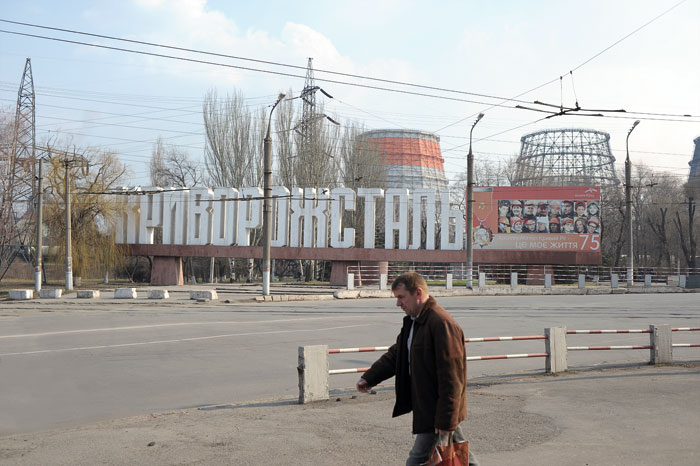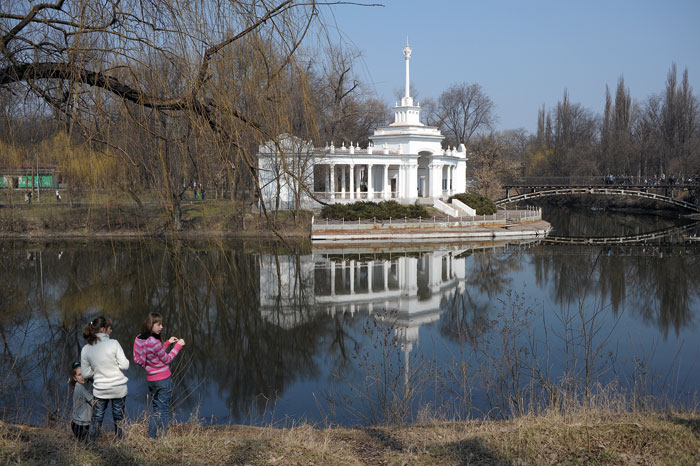Kryvyi Rih is a city of records: Ukraine’s longest city, Ukraine’smost populated city (670,000 people) and the only Ukrainian city with a "metrotram" and arguably the only one with as many as four train stations.
METAL WITH MITTAL
Since the time Kryvorizhstal was purchased by Indian Lakshmi Mittal and rebranded ArcelorMittal Kryvyi Rih, the mass media have largely lost interest in the city. Economists are not exactly hurring to analyze how efficient the foreign investor has been over the past several years compared to Ukrainian oligarchs. Almost all residents agree that the new owner has not caused any apocalypse in the city. The Indians, called baboons by some not quite politically correct locals, have not conducted any large-scale layoffs. Upgrades of capital assets follow the conditions set during privatization. The plant’s social projects have not been downsized — something that opponents to privatization were mostly vocal about. Nevertheless, the two management styles, capitalist Indian and post-communist Ukrainian, are still competing with each other producing bizarre results.

REPRIVATIZED PLANT. Managed by Indians now, it is operating no less efficiently than when was run by Ukrainian oligarchs
“Foreign management strategies have a hard time taking root in Ukraine,” Kryvorizhstal employees say. “For example, the Indians have implemented Western system of purchases based on the ‘buy cheaper and get a bonus’ principle. As a result, the plant keeps buying either inadequate or malfunctioning equipment for peanuts. The plant incurs losses, while its employees get bonuses.”
The plant and the city are in essence one whole. Kryvyi Rih expanded as the metal industry in the region grew. This caused it to stretch out inordinately — the city is 126 km long, north to south. Naturally, this is not the whim of the locals — the city’s shape follows the iron ore vein along which the first miners settled. Today residential blocks stretch along five ore-processing complexes: Inhulets, Southern, Central, Northern, and Novokryvorizkyi.
The ore-processing plants also offer a solution to the problem of public catering: their canteens are open to anyone, both the workers and guests. You can order schnitzels and get an AncelorMittal corporate newspaper on top.

SPIRITUAL CONFLICT. Architectural specimens of the communist era and post-Soviet churches are a bizarre combination
THE PHENOMENON OF KURIER KRYVBASU
“Once I was amused by a woman, who said in absolute earnestness: It’s nonsense that Cossacks have something in common with Kryvyi Rih. She knows nothing about the Inhulets palanka (a type of Cossack fortification) and is not aware that our city is located on the Kyzykermensky road, a fairly busy transport artery in the past,” says Hryhorii Huseinov, an honorary citizen of Kryvyi Rih.
If Kryvorizhstal is the undeniable economic visage of the city, its cultural image is shaped by the literature magazine Kurier Kryvbasu – one of the best-known in Ukraine – and its editor and publisher, Mr. Huseinov. A winner of the Shevchenko Prize he never loses his characteristic smile even as he dishes out criticism of the city’s cultural life.
“Unfortunately the city is not a Mecca for writers and poets. Those born here are trying to move elsewhere. Meanwhile, authorities encouraged mediocrity; party members even attended literary soirees and searched for reprehensible things in poetry. One can, of course, mention unofficial literature and two of its writers, Mykhailo Pronchenko and Mykhailo Oliinyk. Soviet authorities were suspicious of them, and their attempts at literary work under German occupation led to their execution by shooting in 1942. The city’s cultural life today is represented by the two almost defunct branches of the Prosvita society. And it seems to have hit the bottom.”
Mr. Huseinov believes his city to also be apolitical: “People don’t care a bit about who rules them. As Yevhen Dudar once said, a Ukrainian goes to war only when his pig is stolen.”
MINERS’ FAVELAS
The Kryvyi Rih residents often use their own lingo that lon-locals can find hard to understand. For example, the common designation rudnyk (with the initial stress) means a shanty town ridden with social problems and comprised of chaotically scattered small, crudely built shacks called hnydnyky. These improvised dwellings emerged in the 1950s (some in the 1920s and 1930s) and are no better than Brazilian favelas. Generations of menial workers who mine ore using primitive methods have grown up here. Some corners of the city hold entire slums which do not legally exist on paper as real estate. In Soviet times, youngsters formed the bands of so-called bihuny — hooligans who settled accounts among themselves in district-vs-district fights.

PLEASURE BOAT DOCK. Where the Saksahan and Inhulets rivers join
Of course, Kryvyi Rih also has modern residential districts with high rises. But if you go to the top floor of Technical University, you will get a great panoramic view of the city in which islands of tall buildings are scattered in the sea of one-storied houses stretching all the way to the suburbs.
“The story of the ore-mining industry in Kryvyi Rih is centered around the constant conflict between two ways of life — traditional rural and industrial urban,” says Mr. Huseinov. “Peasants who inhabited these lands since time immemorial flatly refused to join the mining profession, so miners had to be brought here, even from Russia. When the industry was launched in 1881, the ethnic composition of the city began to change in a drastic fashion. In addition to Russians, Jews and Germans settled here. Remarkably, the Germans protected the Jews during the pogroms in 1918–1920, while rudnyky residents were ravaged. Even more Kryvyi Rih peasants took part in the war under the command of Otaman Hryhoriev, a popular insurgent leader who fought in the armies led by Symon Petliura and Hetman Skoropadsky.
LIFE NEAR AN OPEN PIT
Guided by a local history expert and ecologist, Mykola Domnichev, we take stock of the Eagle Nest Geological Preserve, an outstanding, national-level specimen of nature. It sprawls between modern residential blocks in the Central districts. Our guide easily breaks off several reddish fragments from a rock and rubs them in his hands. This is an outcropping of ore-bearing rock. What initially looked like a deep ravine is in fact the Pastukhivsky pit. Mining works were launched here in 1899 and the abandoned pit was flooded with water from Saksahan River.
Oremining in this locality ended, but the dwellings stayed. Buildings were often made of scrap materials and lampach (unbaked brick). The oldest buildings have sunk to their windows in the earth. Some of them sit directly on the rock. The locals dump waste straight into the pit without using any sewage works. Steep paths lead to the bottom — dangerous places that provide hiding to criminals and drug addicts.
M FOR METROTRAM
Unlike the suburbs, the city center is neat and clean, complete with a circus and museums (one about Kryvorizhstal and one about local history), as well as a somewhat neglected park with suspension bridges and an ornate boat dock at the confluence of the Saksahan and the Inhulets. The industrial part of the city has streets with a peculiar 1930s design: rows of buildings with first-floor shop windows facing the street. Today several public restrooms have been opened in first-floor apartments after their residents moved out. One of the churches is located in what once was a movie theater.

TRAVELING UNDER THE GROUND. Its stations look like those in a metro, thus the name of this peculiar transport is "metrotram"
They say that one of the greatest mysteries of Ukrainian politics and the economy is where the money from the resale of Kryvorizhstal went. Parliament ruled that one percent of the sum be used for the needs of the city. The resulting financial rain helped municipal authorities buy additional trams for travelling by the city underground.
The entrance is marked by a large green M which signifies the official name of this transport — metrotram. This is a key tourist attraction: electric transport aficionados from Kyiv, Europe and America have visited just for the ride. Outwardly, the stations of this bizarre transport look the same as the Kharkiv subway.
There are several stories explaining the origins of this hybrid. One of them says that the tunnels were initially made for full-fledged metro trains, but regional authorities could not come to terms with the fact that at the time (1986) a district center would have a metro, while the regional center, Dnipropetrovsk, was only starting to build one. Remarkably, metrotrams are not equipped to let passengers get off on the left-hand side as metro trains do. That is why the Kryvyi Rih metrotram system is the only place in the country where driving on the left is legal.
————————————————————————————————————–
Eagle Rocks
Eagle Rocks, a national geological nature preserve, is a group of rocks with a reddish iron outcropping on a hillside that descends to the Inhulets. It is a fragment of the Ukrainian Crystalline Shield and a place where local rock climbers go to practice. Locals can also be seen here having picnics with kebabs as they take a break from the city.
One-eyed first settler
The first written record of Kryvyi Rih is dated 1775 when Kish Otaman Petro Kalnyshevsky ordered the establishment of a post office in the area. This marks the beginning of the city’s official history, but locals justly note that a post office could have been opened if there was already a settlement in place. As an argument against the official version, the local history museum features a picture by a local painter which is the portrait of the city's legendary first settler — a one-eyed (kryvyi na oko) Cossack nicknamed Rih. He provided shelter to the chumaks (Ukrainian traders in 15-19 centuries) who called the locale Kryvyi Rih.
Kryvbas godfather
Kryvyi Rih residents revere Oleksandr Pol as much as people in Donetsk respect John Hughes. This is only natural as the two did business together. As the Welshman was building his iron works in the Donbas, Pol delivered iron ore to him from Kryvyi Rih. Pol, a Ukrainian-German landlord from the Katerinoslav gubernia and, according to Dmytro Yavornytsky, a descendant of Pavlo Polubotok, was a public figure, businessman, and a champion of agricultural, administrative and judicial reform in his gubernia. He was also a noted archeologist and studied iron ore deposits in his homeland for the purposes of commercial production. He found an investor in France and set up Kryvyi Rih Iron Ore JSC, which led to tremendous economic growth over the entire region – the construction of metallurgical plants, the local railway, and a bridge over the Dnipro.
Life in Embryo
For a long time Kryvyi Rih boasted the Ruda (Ore) Hotel, an original building from the 1920s which was unfortunately demolished. However, travelers can stay at a hotel with the equally exotic name Embryo, which is attached to a medical center (UAH 250 per night).
Worth seeing
Metrotramis an underground electric transport network with driving on the left
Kryvorizhstalis an industrial monster that is impossible to miss as it dominates the cityscape
Hnydnykyare shanty towns dating back to the 1950s (some even to the 1920s and 1930s)
The Dnipro–Kryvyi Rih Canalstretches for 42 km, connecting the Saksahan River with the Dnipro and supplying the city with water.

